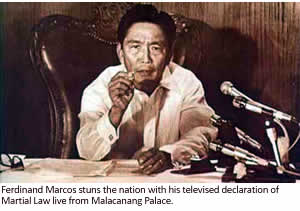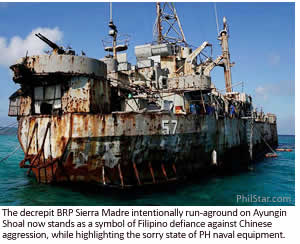 n the evening of September
23, 1972, two days after it had taken effect,
n the evening of September
23, 1972, two days after it had taken effect,
 Ferdinand
Marcos announced via live television from Malacañang Palace that he had placed the
Philippines under Martial Law. It was a calculated move by a devious
politician to keep himself in power beyond what the Constitution allowed. A
staged ambush attempt against his Defense Secretary Juan Ponce Enrile was
the main excuse Marcos (or “Macoy” as he was deridingly referred to back
then) used to strip Filipinos of all their constitutional rights. With that,
the diminutive Ilocano from the backwaters of Batac, Ilocos Norte became the
despotic dictator for over a decade.
Ferdinand
Marcos announced via live television from Malacañang Palace that he had placed the
Philippines under Martial Law. It was a calculated move by a devious
politician to keep himself in power beyond what the Constitution allowed. A
staged ambush attempt against his Defense Secretary Juan Ponce Enrile was
the main excuse Marcos (or “Macoy” as he was deridingly referred to back
then) used to strip Filipinos of all their constitutional rights. With that,
the diminutive Ilocano from the backwaters of Batac, Ilocos Norte became the
despotic dictator for over a decade.
Although little is known
about his childhood years, Marcos appears to have been a cunning, manipulative
individual early on. On September 20, 1935 a day after beating
Mariano Marcos (his father) in the race for the office of representative for
the second district of Ilocos Norte, Julio Nalundasan was killed by a
sniper’s bullet. Marcos and his brother-in-law Quirino Lizardo were accused and
convicted by a Philippine court for Nalundasan’s murder. But as luck would have
it, the conviction was overturned by the Philippine Supreme Court in a
decision penned by then Associate Justice Jose P. Laurel. And because of
that, no member of the Laurel clan was ever harassed during the Martial Law
years.
During the WWII years that
followed, Marcos told the public that those years were spent bravely
fighting the Japanese as a guerrillero. Unfortunately, his guerilla unit
called “Ang Mga Maharlika” was blacklisted by the United States Veterans
Administration after an investigation in 1950 showed that many of its
members were actually Japanese collaborators “trafficking in the sale of critical war
materials to the brutal enemy.”
After the war ended Marcos
filed a claim for over half a million dollars in war reparations. He claimed
he had lost 2,000 head of Brahmin cattle, which he said the US Army commandeered, from
his family’s farm in Mindanao. The Americans of course rejected his
preposterous claim.
While Marcos never stopped
trying to fool the Americans, he saved his greatest deception for the
Filipino people. He pretended to be a statesman interested in uplifting the
lives of his countrymen, when all he wanted to do was enrich himself and
acquire as much power as he could. In 1971 Marcos suspended the writ of
habeas corpus and in 1972 declared Martial Law. With the people’s rights
taken away, Marcos and his henchmen brutally crushed his opponents,
torturing and killing anyone who stood in their way. Colonel Rolando “Rolly”
Abadilla, was a fellow Ilocano and trusted Marcos “thug” who headed the Metrocom
Intelligence Unit. He reported directly to AFP Chief of Staff General Fabian
Ver and stood out because of his sadism and brutality. His torture victims describe him as pure evil. But Abadilla was
just one of the hundreds, if not thousands of Marcos henchmen who spread terror throughout the country during
those dark days.
In many ways the tyrant
Ferdinand Marcos seems to have single-handedly changed Philippine culture.
Since Marcos, Filipinos have become exceedingly cynical of their national government—thus
the “every man for himself” attitude is today widespread. And because we are
no longer pulling together as a nation, we are being left further and further
behind by other countries.
Another debilitating legacy
that Marcos left us with is our distrust of the military. The years of
arbitrary arrests, detention in military stockades, and brutal torture and
“salvaging” (killing) by “beasts” in military uniform have left a
lasting mark on our collective psyche. So that now, 42 years after martial
law was declared and a quarter century since his death, the country is still
being tormented by this very evil man. How so you ask? Because the armed
forces as an institution has been so diminished in the eyes of Filipinos, that
it has been relegated to the sidelines as far as funding and new equipment
are concerned. After all, what sane society would give soldiers shiny new
state-of-the-art weapons when they know those weapons could be easily turned
against them—as they have in the past.
Since martial law, the
Armed Forces of the Philippines (AFP) has been kept at arms-length by the
general populace. Its importance as well as its funding steadily
reduced over the years. And the military does not elicit from Filipinos
that pride and admiration for their men and women in uniform that is so
evident in many other countries. The way they behaved during
martial law is forever etched in the public’s mind.
admiration for their men and women in uniform that is so
evident in many other countries. The way they behaved during
martial law is forever etched in the public’s mind.
So today we have next
to nothing to counter Chinese aggression in the West Philippine Sea (South
China Sea). We have a navy with mostly old rusting ships; an ill-trained
army with a handful of old tanks, and an air force without a single
supersonic jet fighter. Should China decide to grab all our islands in the
West Philippine Sea, we will only have “Macoy” to thank…or blame. While he may be
long dead, his evil deeds continue to torment Filipinos to this day.
Published 09/23/2014